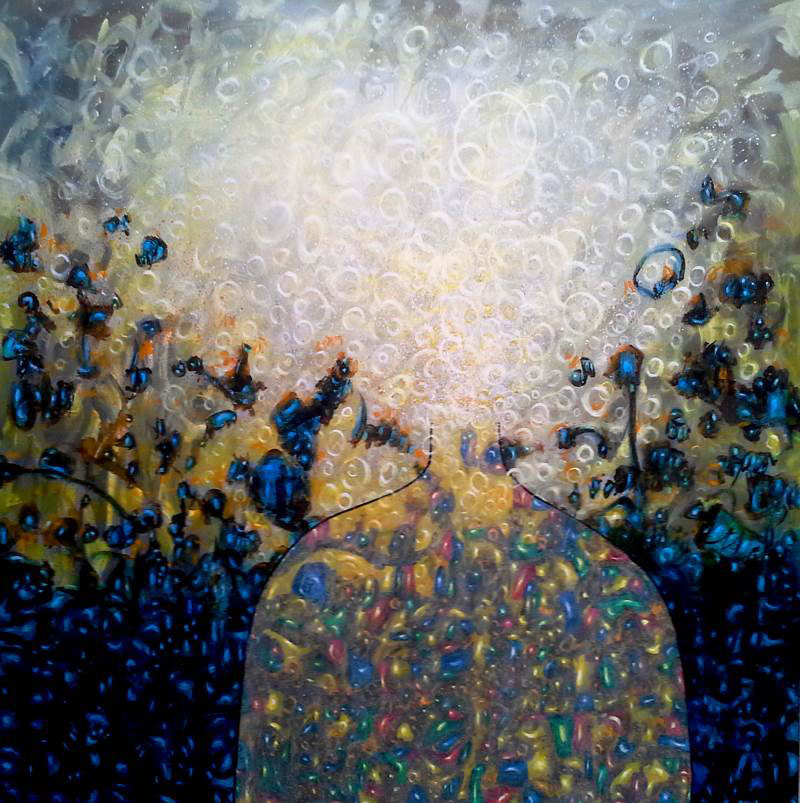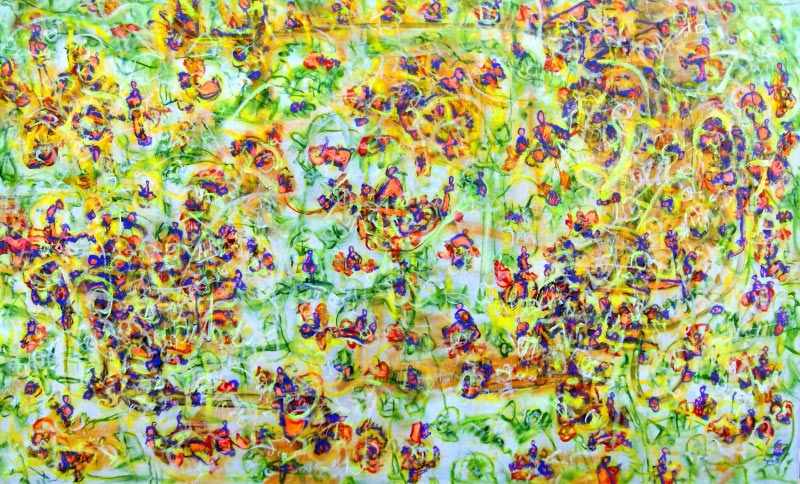The Artist Must Become Secondary to the Art
By Keith Morant
Keith Morant (1944-2022) was an internationally acclaimed, multi-award winning artist. He created expressive oil and mixed media abstract paintings.
He wrote this article for Manhattan Arts International in May, 2016. In this essay about quality in art and the artist’s ego, he proves he was also a master of probing profound topics in art and creativity. He emphasized the significance of the artist’s endeavor to rise above the banality of novelty and become secondary to the art. As he cited T. S. Eliot’s quotation: “The progress of an artist is a continual self-sacrifice, a continual extinction of personality.” To view more of Keith Morant’s artwork visit this page.
 Keith Morant, Tonic, mixed media on canvas, 30″ x 30″. This painting won the Second Place Award in the Manhattan Arts International “The Healing Power of ART” exhibition.
Keith Morant, Tonic, mixed media on canvas, 30″ x 30″. This painting won the Second Place Award in the Manhattan Arts International “The Healing Power of ART” exhibition.
In the consideration of artistic expression, whether as creator or spectator, the most important factor is the ability to discern between what is true quality and what is merely novelty.
Novelty is that which may have popular appeal but fades in its importance with the passing of time. Quality, on the other hand, is that which often, in spite of unpopular or controversial inception, increases in its importance with the passing of time.
Quality in art is an ultimate truth expressed through an individual’s unique experience of existence. Its success in expression and transmission lies in its potential to communicate more than its surface values.
We have witnessed a great shift in human conscious awareness to a level where pictorial art is continually establishing new values and criteria as to what is, and what is not “quality”.
I believe that if the artist of today is to rise above the banality of novelty and escape the seductive forces of popularity and material gain then he must be prepared to sacrifice much. By ‘sacrifice’ I refer to that which T. S. Eliot meant when he said: “The progress of an artist is a continual self-sacrifice, a continual extinction of personality”.
As Eliot implies, the artist must become secondary to the art. Whatever he creates, the artist must express more than just himself; he must convey the deepest truth of his being. Of course, attached to such effort is the great paradox that the ego (the strongest driving force behind any human endeavor) becomes an anathema to such manifestations and must, therefore, be overcome.
As an example, I recall that as a young painter, pride in my new creation was the ego up large and the work would be completed with a very visible signature. As time passed and my confidence increased, the signature became more and more superfluous. The work itself was signatory enough. My name shrunk and became almost indiscernibly hidden in the work.
The artist’s expression must aspire to clarity of vision and vitality of life which is untainted by illusion. His work must always present something that is totally new, but which will begin to age from the moment of first being encountered.
The mind of every new viewer is another birth-place for the work of art – where its potential qualities will enter the psyche as a newborn enters the world. As the knowledge of its existence is assimilated so the ageing process begins – evoking new knowledge, new language and new sense of purpose – and in art, as in life – real progress is always in purpose rather than statement.
Visit Keith Morant’s website at www.morantart.com


Thank you for sharing your thoughts. Not only are you an amazing artist but a superb writer as well. I always enjoy seeing your latest paintings on Facebook.
Hi Keith and thank you for this very interesting article. I agree and would add that part of true quality is the artist’s ability to expose her soul, his deep truth, in the art form. To be willing to show up fully open and naked, completely true to oneself at the moment of creating the art is what, I believe,
T. S. Eliot meant when he said: “…..a continual extinction of personality”, and what you refer to as diminishing ego. Of course, being true to oneself evolves, deepens, and grows over a lifetime.
It is a path with much struggle but also innumerable joy. It takes courage.
I love your piece Neurorhythm it connects with my belief that we are all vibrating particles at different speeds.
Hi Keith
The problem is making art that has integrity and making art for a living. How to be true to your motivation if you are successful with slight alteration for the public taste. Should one take a job and pursue your true motivation? What is your opinion? I would really like to know.
I really liked reading this article.
However, it got me wondering – when you were talking about discerning between quality and novelty, you mentioned the importance of art. How would you characterise the ‘importance’? Is it the societal impact it has or any other factor?
Hi Ann,
Thank you for you interest and question.
I have come to believe that the true function of the artist (alongside of the scientist) is to continually knock at the door of the unknown. To ensure that his knocking gains a response the artist must always maintain a sense of loyalty to his inner necessity. He must continually project his innate vision of being, a vision which must not fall victim to the urges of compromise or be altered in an effort towards popular taste and approval (novelty). Whatever great universality is projected through a work of art, it is always only one individual’s subjective effort towards a conclusion. If the intelligence and intuition of that individual succeeds in rendering a new and vital truth, then it will only be realized through the passing of time and the ongoing expansion of human consciousness and, as has so often been proven, the greater the truth – the longer the time.
So – to answer your question; the importance of ‘quality’ in art lies in its truth and the capacity of that truth to engender a higher awareness and compassion in humanity.
Thanks, Keith. This is a terrific article. I could hardly agree more with what you’ve so beautifully stated here. Your work is new to me, but I enjoy it and will check out your links ASAP.
Thank you very much Barbara! I do not really consider myself as a writer but certain things have to be said somehow.
Best wishes from New Zealand!
I really love ” AUTUMN GROWTH ” YOUR Work is very special
Thank you very much Bea!
It is thanks to dear Renee, who has promoted me for many years, that I am able to reach so many good souls like you. Best wishes to you from New Zealand!
The integrity of Keith’s focus and its consistency over many years speaks for itself. His challenge to and support for other artists is further testimony to his influence and success. Well done Keith, and thank you.
Thank you so much Wil!
Always good to get a response from artists like you.
Looking forward to the next Foundation show!